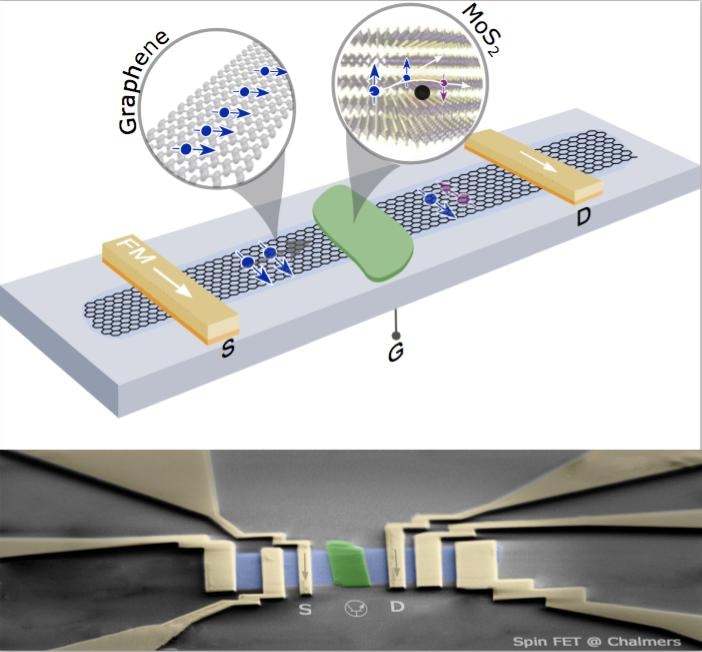Jul 6 2017
A graphene-based spin field-effect transistor with the ability to function at room temperature has been developed by Graphene Flagship Researchers from the Chalmers University of Technology in Gothenburg, Sweden.
 This is a schematic of graphene-MoS2 heterostructure which allows spin injection into graphene from the ferromagnetic source, diffusive spin transport in the graphene-MoS2 heterostructure channel, spin manipulation by a gate voltage and detection of spin signal by the ferromagnetic drain. CREDIT: Spin FET@Chalmers.
This is a schematic of graphene-MoS2 heterostructure which allows spin injection into graphene from the ferromagnetic source, diffusive spin transport in the graphene-MoS2 heterostructure channel, spin manipulation by a gate voltage and detection of spin signal by the ferromagnetic drain. CREDIT: Spin FET@Chalmers.
The outcomes of the research have been reported in a research paper published in the journal Nature Communications. The Researchers have used the spin of electrons in graphene and similar layered material heterostructures to fabricate working devices in a step towards combining memory devices and the logic of spintronics.
The prevalent semiconductor logic devices used in computers tap the flow and control of electronic charge in order to process information. The inherent characteristics of electron spin are used by spintronic memory devices for storing information. In the case of next-generation devices, Scientists are searching for ways to find techniques for combining information processing as well as storage in a single device unit.
Graphene is an excellent medium for spin transport at room temperature, due to its low atomic mass. However, an unsolved challenge was to control the spin current at ambient temperature.
Saroj Dash, Group Leader and Associate Professor at Chalmers University of Technology
At present, Andre Dankert and Saroj Dash, Graphene Flagship Researchers, have demonstrated that the spin characteristics of graphene can be electrically regulated in a controlled way even at an ambient temperature. Apart from unlocking various innovative probabilities in spin logic operations, this study also enables integration with magnetic memory elements in a device unit. If further advancements can assist in the production of a spin current without the need for charge flow, the amount of power needed will be considerably reduced, resulting in highly versatile devices. This will have a specifically significant role as we advance closer toward hand-held mobile computing.
Controlling the flow of spin currents in a transistor-like manner is a decade old dream and the missing link towards all-electrical spin logic applications. Researchers were working for almost ten years to understand the spin transport properties of various layered materials and how they can be tuned to achieve this goal. Our work is an important milestone in the field of spintronics.
Andre Dankert, Author of the Paper, the Chalmers University of Technology
Many research teams from Graphene Flagship have demonstrated the ability of graphene to convey spin over longer distances. Hence if graphene is integrated with another layered material in which spin stays only for a considerably lesser time, a spin field-effect transistor like device can be fabricated.
Saroj Dash, when briefing about developing spintronic devices by using a heterostructure, stated that “By combining graphene, where spin lasts for nano seconds with molybdenum disulfide where spin only lasts for picoseconds you can control where the spin can go by using a gate voltage—essentially you can create a spin switch. Importantly, we show in this research a particular materials mix which enables this spin-switch to work at room temperature.”
We have been working on graphene spintronics for a number of years and we joined the Graphene Flagship because our goals are aligned with that of the Flagship spintronics work package—to investigate room temperature graphene spintronics devices, joining together theoretical and experiment research. The collaborative nature of the Graphene Flagship community, with its focus on face to face meetings has lead to many fruitful discussions within our spintronics field. This collaborative approach also led to a great relationship with our commercial partner Graphenea, who has worked with us to provide the graphene sample we needed.
Saroj Dash, Group Leader and Associate Professor at Chalmers University of Technology
Describing the upcoming processes in his study, Andre Dankert stated, “Now we know the crucial parameters of our device structure, we can optimize it to increase the effective gain and transistor action.”
Various layered materials are propitious for spintronics. Besides investigating the fascinating characteristics of the individual crystals, it is interesting to uncover the potential of their heterostructures. According to Saroj, the larger aim is to develop innovative spin phenomena in devices based on layered materials by piling up disparate layers that have complementary characteristics.
The head of the spintronics work package Bart van Wees added that “The future challenge will be to explore and use the new spintronic functionalities which are made possible by the new van der Waals heterostructures. The Authors already made an important step here.”
Professor Andrea Ferrari, Chair of the Management Panel and Science and Technology Officer of the Graphene Flagship, stated, “Spintronics has been one of the fundamental work packages since the start of the Flagship. It was always seen as a long term investment. It is exciting to see that so much progress has been made towards devices.”